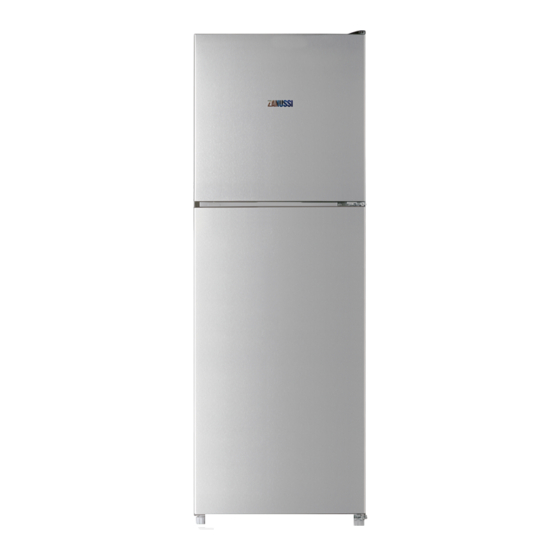Zanussi ZTB2500A-A Instruction Manual - Page 7
Browse online or download pdf Instruction Manual for Refrigerator Zanussi ZTB2500A-A. Zanussi ZTB2500A-A 8 pages.

6.
Cover foods and wipe containers dry before placing them in the refrigerator. This cuts down on moisture build-up
inside the unit.
7.
Do not overcrowd the refrigerator or block cold airvents. Doing so causes the refrigerator to run longer and use more
energy. Shelves should not be lined with aluminum foil, wax paper or paper toweling. Liners interfere with cold air
circulation, making the refrigerator less efficient, which could cause food spoilage.
8.
The arrangement of food for storage and for freezing, where applicable, particularly including advice that food to be
frozen is not to be placed in direct contact with food in storage and, if appropriate, that it could be necessary to reduce
the quantity to be frozen if freezing every day is anticipated.
9.
During prolonged absences (example: vacations), it is advisable to disconnect the refrigerator, remove all the food,
and clean it. The door should be left slightly open to avoid mold and unpleasant odors. This will not affect the
refrigerator when it is reconnected.
10. During short absences (example: holidays), the refrigerator can remain on. However, remember that prolonged power
outages may occur while you are gone.
11. The door to the evaporator clearance can be used to store food.
12. The storage time(s) recommended by the food manufacturers for any kind of food and particularly for commercially
quick-frozen food in food-freezer and frozen-food storage compartments or cabinets.
13. The precautions necessary to prevent an undue rise in the temperature of the frozen food while defrosting the
refrigerating appliance, such as wrapping the frozen food in several layers of newspaper.
14. The care required with regards to frozen food in storage in the event of an extended non-running of the refrigerating
appliance (interruption of power supply or failure of the refrigerating system).
Maintenance and cleaning
1.Internal cleaning
Clean the Refrigerator internally with a weak solution of bicarbonate of soda. Then rinse with warm water using a damp
sponge or cloth and wipe dry. Wash the baskets in warm soapy water and ensure they are completely dry before replacing
in the Refrigerator.
2.External cleaning
Use standard non-abrasive detergent diluted in warm water to clean the Refrigerator exterior.
The grille of the condenser at the back of the Refrigerator and the adjacent components can be vacuumed using a soft
brush attachment.
Do not use harsh cleaners, scouring pads or solvents to clean any part of the Refrigerator
ELECTRICAL INFORMATION
THIS APPLIANCE MUST BE EARTHED.
This appliance is fitted with a plug which will be suitable for use in all houses fitted with sockets to current specifications.
If the fitted plug is not suitable for your socket outlets, it should be cut off and carefully disposed of. To avoid a possible
shock hazard, do not insert the discarded plug into a socket.
Servicing
Simple fault analysis and elimination
Not every failure requires technical service personnel to solve the following simple small problem; you can try to solve the
problem.
Case
Completely non
refrigeration
Abnormal noise
Poor refrigerating
efficiency
Peculiar smell in
refrigerator
Note: If the above description can't be troubleshooting, do not disassemble the repair yourself. Repairs carried out by
inexperienced persons may cause injury or serious malfunctioning. Contact the local store where your purchase was
made. This product should be serviced by an authorized engineer and only genuine spare parts should be used.
When the appliance is not in use for long periods, disconnect from the electricity supply, empty all foods and clean the
appliance, leaving the door ajar to prevent unpleasant smells.
Classified as Internal
Inspection
Is power plug off?
Are breakers and fuses a broken?
No electricity or line trip?
Is refrigerator stable?
Does refrigerator reach the wall?
Do you put hot food or too much food?
Do you open the door frequently?
Do you clip food bag to the seal of
door?
Direct sunlight or near a furnace or
stove?
Is it well-ventilated?
Temperature setting in too high?
Any spoiled food?
Do you need to clean refrigerator?
Have you packed food of strong
flavors?
Solutions
Re-plug.
Opening the door and checking whether the
lamp is lit.
Adjusting refrigerator's adjustable feet.
Off the wall.
Putting food into refrigerator when hot food
becomes cool.
Checking and closing the door.
Removing the refrigerator from the heat
source.
Emptying the distance to maintain good
ventilation.
Setting to the appropriate temperature.
Throwing away spoiled food.
Cleaning refrigerator.
Packing food of strong flavors.
7
